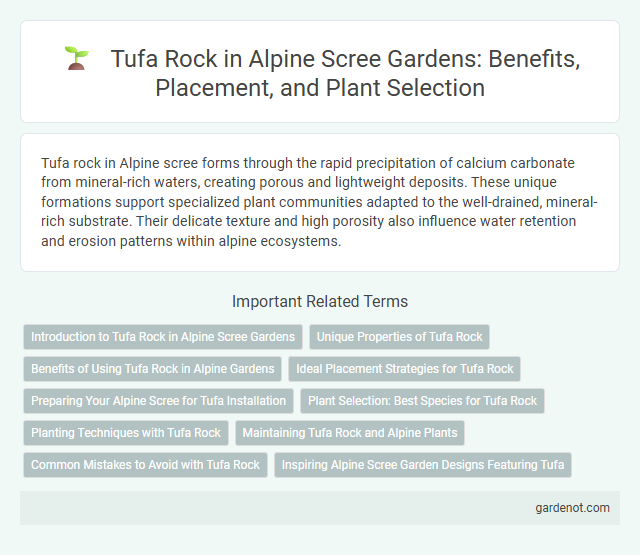Tufa rock in Alpine scree forms through the rapid precipitation of calcium carbonate from mineral-rich waters, creating porous and lightweight deposits. These unique formations support specialized plant communities adapted to the well-drained, mineral-rich substrate. Their delicate texture and high porosity also influence water retention and erosion patterns within alpine ecosystems.
Introduction to Tufa Rock in Alpine Scree Gardens
Tufa rock is a porous, lightweight sedimentary rock formed by the rapid precipitation of calcium carbonate from mineral-rich water, commonly found in Alpine scree gardens. Its unique structure provides excellent aeration and water retention, promoting healthy root growth for alpine plants adapted to scree environments. This makes tufa an essential component in creating naturalistic alpine scree gardens that replicate high-altitude habitats.
Unique Properties of Tufa Rock
Tufa rock, a type of porous limestone, forms from the precipitation of carbonate minerals in alpine scree environments, creating a lightweight yet durable structure. Its high porosity and low density enhance water retention and support unique microhabitats, fostering diverse alpine plant species. The rock's ability to trap and slowly release moisture makes it essential for sustaining fragile ecosystems amid harsh mountainous conditions.
Benefits of Using Tufa Rock in Alpine Gardens
Tufa rock enhances alpine gardens by providing excellent drainage and aeration essential for delicate alpine plants' root systems. Its porous structure retains moisture while preventing waterlogging, promoting healthy growth in rocky, well-drained environments. Incorporating tufa rock also mimics natural mountain habitats, supporting native plant diversity and stability in alpine scree conditions.
Ideal Placement Strategies for Tufa Rock
Ideal placement strategies for Tufa rock in alpine scree involve situating the rock in well-drained, sun-exposed areas to mimic its natural chalky habitat and promote weathering processes. Positioning Tufa near moisture sources enhances its porous structure, facilitating colonization by specialized alpine flora and supporting microhabitats for endemic species. Arranging Tufa rocks in clusters maximizes their ecological function, stabilizing scree slopes and contributing to biodiversity within alpine ecosystems.
Preparing Your Alpine Scree for Tufa Installation
Preparing your alpine scree for tufa installation involves thoroughly cleaning the area to remove loose debris and organic matter, ensuring a stable foundation for the porous tufa rock. Proper site leveling and compacting the scree prevent unwanted shifting, promoting long-term durability and integration of the tufa in alpine garden settings. Incorporating a layer of gravel beneath the tufa aids in optimal drainage, reducing moisture retention that can compromise the rock's structural integrity.
Plant Selection: Best Species for Tufa Rock
Plants thriving on tufa rock prefer species adapted to well-drained, alkaline substrates with low nutrient availability. Saxifraga, alpine sedums, and irises are ideal due to their tolerance to mineral-rich, porous tufa surfaces and ability to anchor in crevices. Selecting drought-resistant, low-maintenance perennials ensures optimal growth and enhances the natural texture of alpine scree environments.
Planting Techniques with Tufa Rock
Tufa rock, a porous and lightweight limestone, offers excellent water retention and aeration properties ideal for alpine scree planting techniques. Its natural crevices and rough texture provide secure anchorage for delicate alpine plants, promoting root stability and minimizing soil erosion. Effective planting involves embedding seedlings into tufa's cavities, ensuring moisture access while simulating native rocky habitats for optimized plant growth and resilience.
Maintaining Tufa Rock and Alpine Plants
Maintaining tufa rock in alpine scree involves preserving its porous structure, which supports moisture retention essential for alpine plants' survival in harsh environments. Regular monitoring prevents erosion and biological degradation, ensuring stability for delicate root systems of species like Saxifraga and Edelweiss. Implementing erosion control measures and limiting foot traffic enhances tufa's natural role as a habitat for diverse alpine flora.
Common Mistakes to Avoid with Tufa Rock
Common mistakes to avoid with Tufa rock include improper sealing, which can lead to moisture absorption and deterioration over time. Using harsh cleaning agents or high-pressure washing can damage its porous texture and cause discoloration. Failing to support the rock structurally in construction can result in cracking due to its relatively soft and brittle nature.
Inspiring Alpine Scree Garden Designs Featuring Tufa
Tufa rock's porous texture and lightweight nature make it an ideal material for alpine scree garden designs, promoting excellent drainage and supporting moisture-loving alpine plants. Its natural weathering enhances the garden's aesthetic, creating a rugged, authentic alpine environment that encourages diverse plant growth. Incorporating tufa in scree gardens boosts ecological balance by providing microhabitats for specialized flora, emphasizing sustainable and inspiring landscape design.
Tufa rock Infographic

 gardenot.com
gardenot.com